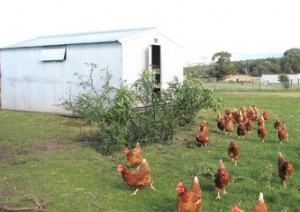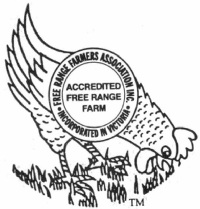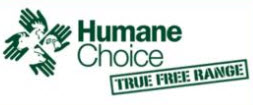
(Photo courtesy of FRFA)
[dropcap] I [/dropcap] ‘ve been buying and using free range eggs for a very long time.
I can’t remember when I first read about the treatment of ‘battery hens’, or first saw heartbreaking footage of the cruel conditions in which many of them are kept. And it’s only this year that Tasmania has become the first (and so far the only) state in Australia to announce that it will legislate to ban battery hen farming.
So for many years now I’ve always walked past the cartons of cage eggs and ‘barn laid’ eggs and picked one labelled free range.
But I was shocked to discover recently that I’ve been well and truly fooled! ‘Free range‘ does not necessarily mean what I thought it did.
A Choice Magazine article in May this year highlighted the fact there is no official national standard for free range eggs, and the conditions under which the birds are raised can vary widely. As Choice points out, there are several different bodies involved:
Certification standards are set by a range of industry bodies including the Australian Egg Corporation Ltd (AECL, the group which represents most egg producers), Free Range Egg and Poultry Australia (FREPA) and the Free Range Farmers Association Victoria (FRFA) and animal welfare organisations such as the RSPCA and Humane Society International. Most organic certification standards also address free range conditions.

And an accompanying table shows there’s considerable difference between the certifying bodies in terms of the standards they use. For example, the RSPCA does not require that hens have ready daylight access to the outdoors! ‘Free range’ hens that don’t and can’t go outdoors in daylight? There’s something wrong with that picture!
Another controversial issue on which the bodies differ is that of beak trimming – four of them allow it and four do not. Here’s what the RSPCA says about the issue:
Beak trimming is routinely performed on poultry in egg production systems to avoid, or mitigate, the effects of feather pecking and cannibalism. Beak trimming is often mistakenly referred to as ‘de-beaking’. Beak trimming involves the partial removal of the bird’s upper and lower beak (not the whole beak) either with a hot blade, a laser or infrared technology. The beak becomes blunt and, when pecking other birds, there is no or very little impact.
Beak trimming can result in birds developing neuromas (bundled nerve endings) at the tip of their beak which makes eating very painful. This is a chronic condition that cannot be overcome.
The RSPCA believes preferable options for the management of feather pecking and cannibalism are the selection of less aggressive bird strains and use of alternative flock management practices (including rearing and husbandry practices and the provision of environmental enrichment devices) that will eliminate the need for beak trimming. Beak trimming as a means of curbing feather pecking or cannibalism should only occur as a last resort and under veterinary advice.
Very surprisingly though, perhaps because they fall back on the ‘last resort’ and ‘veterinary advice’ clauses, the RSPCA allows beak trimming when certifying eggs as free range!
Research indicates that feather pecking and cannibalism – the main reasons for beak trimming – can result from overcrowding.

So it was with great surprise I learned that the AECL, one of the certifying bodies, is proposing legislation that will significantly increase the permitted number of hens per hectare that can still be designated ‘free range’.
The proposed increase? From a maximum of 1,500 per hectare to an incredible 20,000 per hectare!
Fortunately, there are also strong moves to combat this proposal. For example, Choice Magazine has a Free Range Eggs Petition and there are currently two identical Bills before Parliament, introduced by two different MPs, seeking to cap stocking densities for free range layer hens at 1,500 per hectare.
I’ll be watching the outcome of the debate closely!
And from now on, I’ll be even more careful when I’m looking at those free range eggs in supermarkets here in Victoria. I’ve done a bit more research and I’ve figured that, before I even pick it up, a carton will have to be certified by either the FRFA or Humane Choice and have one of the two labels I’ve included in this post!
Among other standards, these two bodies limit the number of hens per hectare, prohibit beak trimming, prohibit the addition of antibiotics, growth promoters or hormones to the hens’ food and mandate unrestricted access to the free range area during daylight hours.
Finally, here’s a video, produced by the Free Ramge Farmers’ Association, that provides a few more details and shows what free range hen farming should look like:
Honestly, barned hens would probably be kinder on and healthier to the hens than 20,000 birds to the hectare . We have about 10 or so Hectares that we move our 1500 odd hens on. They are behind an electric fenced area of about half a hectare for a week at a time. If we are caught by wet weather that becomes quite messy. 20,000 per hectare(over ten times what we have) would probably mean: no herbage in a day or two, smelly mess in a week or less, no beneficial soil boilogy soon after and only non productive regenerative vegetation(weeds) for quite a while when(if) the hens were removed. In our opinion this would add up to environmental destruction in the immediate area and downstream, poultry health problems and less than satisfactory human food production. The idea that more birds per unit area means more production efficiency per unit area may be flawed as well because a moving flock can encourage: much greater carbon sequestration(one unit of nitrogen with the right biology can capture up to 30 units on carbon), increase productivity of the pasture so that more cattle or other herbivores can be grazed per unit area(same area, different time) and create an area that can be cropped without fertilizer inputs.
Let us hope that sanity prevails.